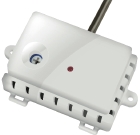Sensor prevents condensation

Sontay has launched a sensor to prevent condensation by providing a reliable early warning of condensing conditions in chilled-surface applications such as chilled beams or ceiling systems. The WD-CPS sensor is described as perfect for this type of project where consultants, contractors and systems integrators need to provide control safeguards to avoid the risk of condensations dripping down.
The WD-CPS operates on dewpoint temperature rather than a fixed value of relative humidity. The dewpoint is calculated from a temperature-compensated relative-humidity element and a high-accuracy thermistor, both of which are thermally bonded to the metal plate of the device. It is secured to the surface being monitored.
The switching set point is 3°C ± the potentiometer offset above the current dewpoint. The output relay is activated when the dewpoint temperature is below the offset set point. To obtain maximum accuracy over a narrow band of RH values, the device will not perform valid calculations on levels of RH below 75%.
A red LED visible through the top of the housing blinks once every 15 s to show the device is working properly. A rapid blinking shows the dewpoint switching set point is close. The LED remains alight when the output is switched on. A long flash followed by two short flashes indicates a problem with the sensor.







